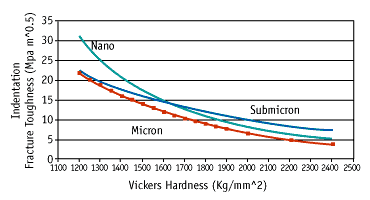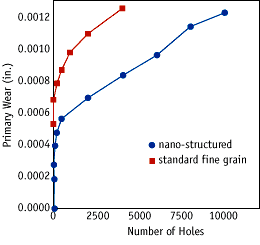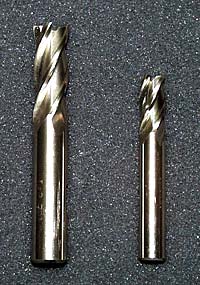How big is small? When it comes to defining the grain size for nanosized tungsten-carbide (WC) powders, it depends on who you ask.
According to Fachverband Pulver Metall, the German society of powder-metallurgy engineers, the average grain size needs to be less than 0.2µm for the material to be considered nano-WC. (“Nanos” is Greek for “dwarf,” and a nanometer represents one-billionth of a meter. A single red blood cell is about 8,000 nanometers in diameter.) In addition, the association defines ultrafine as having a grain size from 0.2µm to 0.5µm, submicron as 0.5µm to 0.8µm and fine as 0.8µm to 1.3µm.
| If tungsten-carbide grains were enlarged, here’s how they’d compare. |
||||
 |
 |
 |
 |
 |
| Basketball (normal size) |
16" Softball (fine) |
Baseball (submicron) |
Golf ball (ultrafine) |
BB shot (nanosize) |
Ganesh Skandan, vice president of R&D for Nanopowder Enterprise, a Piscataway, N.J., supplier of nanocrystalline oxide powders, disagreed with the German engineering society. He puts the diameter of a nanosize grain at under 0.1µm—the size at which significant changes in the carbide material’s structure and properties occur. Those properties include a higher level of hot hardness without any loss in fracture toughness.
T.S. Sudarshan, vice president of Materials Modification Inc., Fairfax, Va., agreed that nano-WC means less than 0.1µm. He indicated that the hardness for nano-WC would measure about 2,800 to 3,000 on the Vickers scale and exhibit a 5 to 50 percent increase in wear resistance compared to material made from submicron powders.
The strength and toughness of nano-WC materials is due to their having a greater number of grain boundaries, which is directly related to the decreased size of each grain.
Are Nanotools Needed?
There are plenty of carbide tools made from submicron, fine and ultrafine grains. But, based on the experts interviewed for this article, no nano-WC metalcutting tools are commercially available.
Bernard North, director of material and process development for Kennametal Inc., Latrobe, Pa., explained that there are several reasons why nano-WC composites aren’t currently used for traditional metalcutting tools. Nanometals have a high hot hardness level—and, therefore, high abrasion resistance—at low temperatures. But as the temperature increases during a metalcutting operation, the hardness advantage is lost. “There’s no hardness advantage above 500° C,” he said. “You’re dealing with basic physics and you can’t overcome that.”
In addition, North said that thermal conductivity decreases as grain size diminishes and that nano-WC boundaries restrict the flow of heat within the tool. This creates problems with thermal fatigue and leads to softening of the tool’s edge.
“Ideally, you want the heat to stay in the chip, but in reality there is some heat that does go into the tool,” North said. He also mentioned that the tendency is to use finer-grain carbides in the manufacture of solid round tools, especially coated ones.
“As coating technologies have improved to keep more heat out of the tool, thermal conductivity and the hot-hardness issue have become less important,” North said.
Some contend that when it comes to nanometals, the thermal-conductivity issue isn’t easy to characterize.
 Figure 1: Relation between fracture toughness and hardness for different grain sizes. |
“The physical properties change so dramatically in nano-WC materials that some prediction models don’t hold true,” said Purnesh Seegopaul, general manager of Union Minière USA Inc.’s Research North America division, New Brunswick, N.J.
Sudarshan doesn’t believe that restricted heat flow represents a roadblock to the development of nano-WC cutting tools. “It can be overcome through intelligent tool design,” he said.
Both Materials Modification and Union Minière (UM), through its Nanodyne Inc. subsidiary, produce nano-WC powders using different proprietary methods (see accompanying article, page 61). Seegopaul said tool manufacturers are a couple years away from making nano-WC metalcutting tools available. However, he added that UM’s nano-WC powders are used to manufacture carbide-tipped tools for the mining industry.
Sudarshan said his company is promoting its product as a coating for jet engine parts and as a material for printed circuit board (PCB) drills. Given the small size of PCB drills, these tools might benefit from nano-WC technology.
Rogers (Ark.) Tool Works Inc. published a paper in 1994 that’s titled “The Application of Nano-Structured WC-Co Composite in the Manufacturing of PCB Drills.” The authors, Z. Zak Fang, Scott Tindle, Jimmy Eason and J. Mike Reed, tested prototype PCB drills made from UM’s Nanocarb powder against standard products. Nanostructured PCB drills reportedly exhibited 30 to 46 percent less wear than the standard tools.
 Figure 2: Typical curves of primary wear of the nano-WC and fine-grain PCB drills vs. the number of holes drilled. According to this evidence, nanodrill’s tool life is 2.5 times that of standard drills. |
In addition, the paper stated that tool life is often defined as the life at 0.0012" of primary wear. According to this criterion, the tool life of the nanodrills tested was 2.5 times that of standard drills (see Figure 2).
Seegopaul said that manufacturers can make cutting tools using nano-WC powder, but the grains grow beyond the nanoscale when the tool is sintered. The production of a nano-WC tool will require the development of improved grain-growth inhibitors and new grain-consolidation techniques.
Inhibiting Growth
Pressed parts are sintered at temperatures between 1,250° and 1,500° C. These temperatures increase grain size such that the post-sintered material is no longer nanosized and no longer exhibits the desired high hardness and fracture toughness.
All carbide grains grow during sintering. But nano-WC pArticles are especially susceptible to coarsening during sintering, according to a Materials Modification paper titled “Nano-Grained Tungsten Carbide-Cobalt (WC-Co),” written by Zhengui Yao, Jacob Stiglich and T.S. Sudarshan.
Grain growth during sintering can be inhibited by adding small quantities of vanadium or chromium, said Reuven Porat, director of R&D for Iscar Ltd., Israel, in his paper titled “New Generation of Cemented Carbide Based on Nanocrystalline WC-Co Powders.”
Although vanadium is the most common inhibitor, Sudarshan added that tantalum, silicon and boron are used, too, although they’re more expensive.
Porat reported that the amount of inhibitor added to the mixture depends on the grain size. The smaller the size, the higher the inhibitor content needed. The inhibitor amount also rises with the cobalt—or binder—content.
There is an optimum inhibitor content for each composition, an amount that results in the highest possible fracture toughness and the best mechanical properties, Porat wrote. He added, though, that too high of an inhibitor content drastically decreases transverse rupture strength and fracture toughness. This would increase tool chipping and breakage—especially with small-diameter drills.
Microwave sintering is one possible method for limiting grain growth, said Seegopaul. This method offers a short sintering time and rapid grain consolidation, which limits grain growth.
During the first few minutes at the sintering temperature, according to Sudarshan’s paper, grains grow very rapidly—probably via coalescence. After the initial stage, grain growth follows the linear relationship of coarsening.
Seegopaul said that although still in the developmental stage, commercialization of microwave sintering is expected soon.
Sudarshan said that microwave sintering shows promise for inhibiting grain growth, but noted that the method limits sintering to a few parts at a time, creating problems with economies of scale for tool manufacturers.
“It will be a long time before industry accepts it,” he said.
So, for now, nano-WC metalcutting tools remain nonexistent, but the research continues. And as research in the broader area of molecular nanotechnology manufacturing goes on, futurists in the global scientific community envision a time when metals and other materials won’t be machined at all. They foresee a time when “nanobots” will collect and assemble atomic pArticles into high-precision parts and products, providing complete control of the manufacturing process, with every atom in its proper place.
| Producing Nano-WCs |
| It’s not possible to attain a nanometal by breaking down a material into progressively smaller parts. Nanopowder Enterprises’ Ganesh Skandan said that nanostructures are produced using a “bottom-up” rather than a “top-down” approach.
“It’s like putting individual molecules together and limiting the number of molecules in each grain,” Skandan said. When producing Union Minière’s Nanocarb powders, Purnesh Seegopaul said that there are three critical legs to the company’s patented Spray Conversion Process. The first calls for preparing and mixing aqueous solutions of the chemical precursor compounds to fix the starting solution’s composition. The next involves spray drying of the starting solution to form a chemically homogenous powder. Finally, thermochemical conversion of the powder creates the desired nanostructured tungsten-carbide grains. A typical Nanocarb powder particle consists of a hollow, porous sphere containing hundreds of millions of WC grains in a cobalt matrix, said Seegopaul. Because the process begins with a solution, the powder’s components are mixed on the molecular level, with each grain measuring less than 0.05µm. The process does not involve pulverization. Materials Modification developed and patented its own unique method for producing nanopowders, including WC. Called Plasma Pressure Compaction, or P2C, the company’s T.S. Sudarshan said the process creates plasma and then chemically cleans the surfaces of the plasma pArticles, allowing the pArticles to bond together while keeping the grain size under 0.1µm. —A. Richter |
| Nanomaterials Used to Coat Wear Parts |
| The U.S. Navy recently announced that it will use a new nanostructured coating to extend the service life of machinery. The coating’s first application will be as a replacement for hard chrome on a series of submarine components.
Developed under the Office of Naval Research Science and Technology Affordability Initiative and the DOD Dual Use S&T Program, the coating is a nanostructured version of a conventional alumina-titania ceramic composite. To apply the coating, off-the-shelf equipment is used. “The mechanical properties of materials begin to change drastically as we reduce grain size into the nanoscale regime,” said Lawrence Kabacoff, program officer of the ONR Materials Division. “The nanostructured version of this ceramic composite exhibits a toughness and strain tolerance unprecedented in traditional ceramic materials. The bond strength is double and the wear resistance is quadruple that of conventional alumina-titania. The resistance to impact is so good that we have to come up with new tests to measure it.” Maurice Gell of the University of Connecticut led a team of university, industry and Navy scientists in the development of the coating. The alumina-titania coating is the first in a series of nanostructured coatings being developed for Naval and civilian applications. Other teams are working on cemented-carbide, chrome-oxide, yttria-stabilized-zirconia, and aluminum- and nickel-based coatings. The Navy anticipates wide use of these coatings on ships, aircraft and land vehicles. —A. Richter |
| Nanonickel Tool Coatings | ||
Nanocrystalline nickel-alloy coatings could prove to be another way to increase a cutting tool’s hardness and toughness. Gino Palumbo, president of Integran Technologies, Toronto, said that his company produces nanonickel coatings using the electrodeposition techniques developed at Queen’s University, Kingston, Ontario; the University of Toronto; and Ontario Hydro. “We adapted conventional electroplating techniques, so our process for producing nanocrystalline coatings is dirt cheap,” said Palumbo. Uwe Erb, scientific advisor for Integran and a professor at the University of Toronto’s Department of Metallurgy and Material Science, said the electrodeposited material is a film that can be applied to any thickness and to an existing tool. He said that the material is always solid and never in a powder form. Although the company is focusing on coatings, Palumbo said that the process could be used to electroform an entire tool. Either way, he said that commercial applications for cutting tools are probably at least two years away. —A. Richter |
Related Glossary Terms
- chatter
chatter
Condition of vibration involving the machine, workpiece and cutting tool. Once this condition arises, it is often self-sustaining until the problem is corrected. Chatter can be identified when lines or grooves appear at regular intervals in the workpiece. These lines or grooves are caused by the teeth of the cutter as they vibrate in and out of the workpiece and their spacing depends on the frequency of vibration.
- composites
composites
Materials composed of different elements, with one element normally embedded in another, held together by a compatible binder.
- fatigue
fatigue
Phenomenon leading to fracture under repeated or fluctuating stresses having a maximum value less than the tensile strength of the material. Fatigue fractures are progressive, beginning as minute cracks that grow under the action of the fluctuating stress.
- fracture toughness
fracture toughness
Critical value (KIC) of stress intensity. A material property.
- hardness
hardness
Hardness is a measure of the resistance of a material to surface indentation or abrasion. There is no absolute scale for hardness. In order to express hardness quantitatively, each type of test has its own scale, which defines hardness. Indentation hardness obtained through static methods is measured by Brinell, Rockwell, Vickers and Knoop tests. Hardness without indentation is measured by a dynamic method, known as the Scleroscope test.
- land
land
Part of the tool body that remains after the flutes are cut.
- lapping compound( powder)
lapping compound( powder)
Light, abrasive material used for finishing a surface.
- mechanical properties
mechanical properties
Properties of a material that reveal its elastic and inelastic behavior when force is applied, thereby indicating its suitability for mechanical applications; for example, modulus of elasticity, tensile strength, elongation, hardness and fatigue limit.
- metalcutting ( material cutting)
metalcutting ( material cutting)
Any machining process used to part metal or other material or give a workpiece a new configuration. Conventionally applies to machining operations in which a cutting tool mechanically removes material in the form of chips; applies to any process in which metal or material is removed to create new shapes. See metalforming.
- sintering
sintering
Bonding of adjacent surfaces in a mass of particles by molecular or atomic attraction on heating at high temperatures below the melting temperature of any constituent in the material. Sintering strengthens and increases the density of a powder mass and recrystallizes powder metals.
- tolerance
tolerance
Minimum and maximum amount a workpiece dimension is allowed to vary from a set standard and still be acceptable.
- tungsten carbide ( WC)
tungsten carbide ( WC)
Intermetallic compound consisting of equal parts, by atomic weight, of tungsten and carbon. Sometimes tungsten carbide is used in reference to the cemented tungsten carbide material with cobalt added and/or with titanium carbide or tantalum carbide added. Thus, the tungsten carbide may be used to refer to pure tungsten carbide as well as co-bonded tungsten carbide, which may or may not contain added titanium carbide and/or tantalum carbide.
- wear resistance
wear resistance
Ability of the tool to withstand stresses that cause it to wear during cutting; an attribute linked to alloy composition, base material, thermal conditions, type of tooling and operation and other variables.


